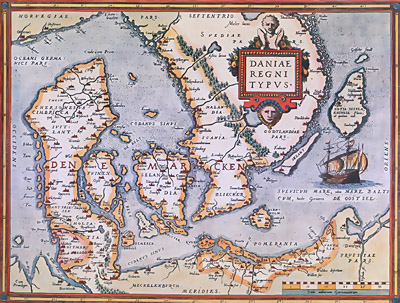| Den nordiske syvårskrig 1563-70

| | Omkring 1560 er to unge stridslystne konger, Frederik 2.og Erik 14., kommet på tronen og det trækker op til direkte konfrontationer, som udløses med Den Nordiske Syvårskrig Krig fra 1563-70.
De konkrete årsager til krigsudbruddet var mangfoldige og banale, men det grundlæggende forhold var at Sverige efterhånden følte sig omklamret og indespærret af det dansk-norske kongerige. |
Unionens ophør
De nordiske samlingsbestræbelser der, med vekslende held, pågår under dronning Margrethes Kalmarunion fra 1397 rinder endeligt ud i begyndelsen af 1500-tallet, hvor der også går en bølge af national vækkelse over både Danmark og Sverige.
Det første tiår af 1500-tallet er en lang konfrontation imellem de to parter og med Christian 2.og Det Stockholmske Blodbad i 1520 sættes punktum for unionsbestræbelserne.
I tiden herefter etablerer Sverige sig for alvor som nationalstat, der opstår et skærpet modsætningsforhold, men Brömsebropagten fra 1541 forhindrer indtil videre direkte konfrontationer.
Stridslystne konger
Omkring 1560 er to unge stridslystne konger, Frederik 2.og Erik 14. , kommet på tronen og det trækker op til direkte konfrontationer, som udløses med Den Nordiske Syvårskrig Krig fra 1563-70. De konkrete årsagerne til krigsudbruddet var mangfoldige og banale, men det grundlæggende forhold var at Sverige efterhånden følte sig omklamret og indespærret af det dansk-norske kongerige.
Det havde længe generet at eksport sydover fra Småland skulle igennem danske besiddelser og mod vest havde Sverige kun en udsat støttepunkt ved Götaelvens munding, Älvsborg.

Kort fra 1570. | 
Sverige følte sig indespærret. | 
Belejringen af Elfsborg 1563. |
Civil terror
I 1563 udbryder der krig. Älvsborg blev erobret af danskerne i september 1563 og måtte i sidste ende købes tilbage af svenskerne. Der kæmpes indædt både til vands og til lands og ved krigens afslutning er begge riger dybt forarmede, bl.a. af enorme udgifter til de for tiden typiske lejesoldater, som betragtede plyndring og hærgen som en del af deres betaling. Strategien var så vidt muligt at undgå direkte konfrontationer og militære tab og i stedet at lade civilbefolkningen holde for.
Værst gik det udover civilbefolkningen i Skånelandene og Sydsverige, -begge parter i krigen anvendte terror mod civilbefolkningen i et hidtil uset omfang. Rönneby i Blekinge bliver angrebet d. 4. september 1564 af svenskerne og kong Erik beretter selv lidt senere herom:
”Rødt som blod farvedes vandet af de døde kroppe. Fjenderne var så forskræmte, at man ikke havde megen umag med dem, men stak dem ned som en flok svin, så at i staden blev mere end to tusinde mand uden halsen, foruden kvinder og børn, som finnerne slog ihjel.”
Blokadevåben
Danmark anvender i 1565 en blokade af Øresund som våben i krigen og skaber sig herved farlige fjender. Sverige var selvforsynende med fødevarer, men især Holland var dybt afhængig af kornforsyninger fra de baltiske lande og rammes hårdt. Der udbryder hungersnød i landet og både Holland og Spanien overvejer at erklære Danmark krig.
Hertil kommer at Øresundstolden i 1567 omlægges og hæves betydeligt. Indtægten heraf stiger på et år fra 45.000 rigsdaler i 1566 til 132.000 det efterfølgende år, men Frederik 2.s. 3000 lejesoldater kostede alene 150.000 daler, - om måneden!
Den 13.december 1570 underskrives en fred i Stettin, som forsøger at tage højde for mægling i fremtidige konflikter. De danske og svenske rigsråder forhindrer i et godt stykke tid fremover yderligere konfrontationer, men i det efterfølgende århundrede bliver Øresundsregionen gentagne gange hærget af krigshandlinger.

Kampen om Østersøen | 
Svenske skibe i Øresund |
|